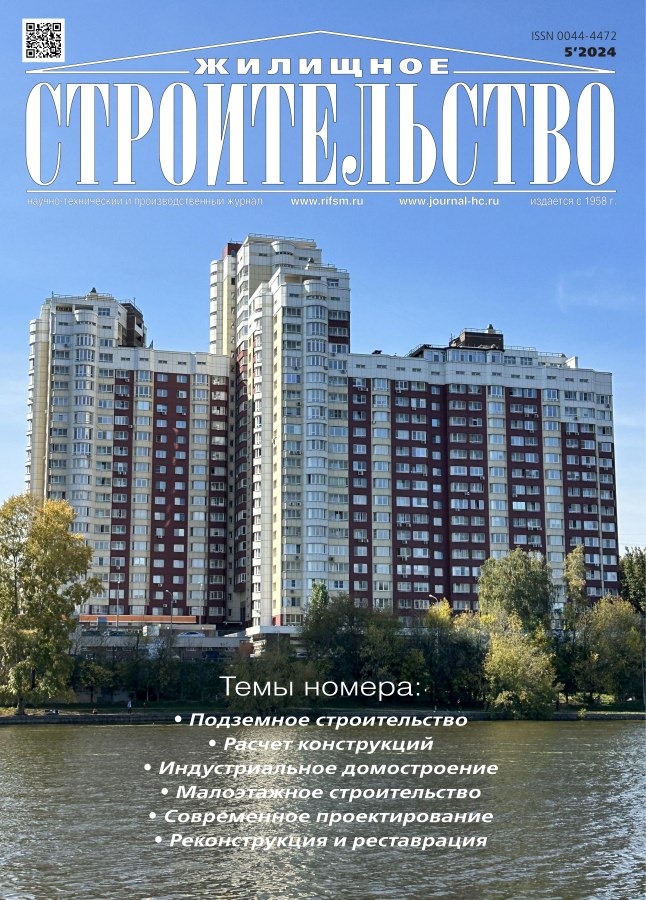Influence of Reinforcement of Reinforced Concrete Beams Subjected to Biaxial Bending on the Position of Their Neutral Axis
- 作者: Cherepanov V.S.1, Vorontsova N.S.1, Rudniy I.A.1
-
隶属关系:
- Saint-Petersburg State University of Architecture and Civil Engineering
- 期: 编号 5 (2024)
- 页面: 13-21
- 栏目: Articles
- URL: https://gynecology.orscience.ru/0044-4472/article/view/634776
- DOI: https://doi.org/10.31659/0044-4472-2024-5-13-21
- ID: 634776
如何引用文章
详细
In building habits, members that are in a state of biaxial bending are often encountered. For example, reinforced concrete purlins, contour beams, crane beams, reinforced concrete frame elements. Despite the fact that building codes contain recommendations for the calculation of members subjected to biaxial bending, the issue of rational placement of reinforcement in the section remains relevant. The article reviews the work in this scope and concludes that there is insufficient research on the effect of reinforcement on the position of the neutral axis. The importance of the relationships under consideration is due to their direct connection with the load-bearing capacity of members subjected to biaxial bending. The purpose of the research is to determine the influence of the location of the reinforcement in the section and the ratio of its dimensions on the position of the neutral axis in a member subjected to biaxial bending. The authors calculated beams with various options for the location of the reinforcement in the section and analyzed the influence of the location of the reinforcement and the ratio of the dimensions of the reinforced concrete members on the position of the neutral axis. The angle of inclination of the axis and the area of the compressed zone of concrete were chosen as parameters determining the position of the neutral axis. Corresponding relationships were established between the effective depth of the section, the ratio of the beam dimensions and the parameters characterizing the position of the neutral axis. The calculation was carried out in accordance with state-of-the-art-type design regulations on ultimate forces and on a nonlinear deformation model. A comparison of the results obtained by the two methods showed both a general and opposite nature of the change in relationships, which is reflected graphically; numerical disarrangements were also identified due to the accuracy of the calculation, the prerequisites and assumptions underlying them.
全文:
作者简介
V. Cherepanov
Saint-Petersburg State University of Architecture and Civil Engineering
编辑信件的主要联系方式.
Email: vladcher99@yandex.ru
Graduate Student
俄罗斯联邦, 4, 2nd Krasnoarmeyskaya Street, Saint Petersburg, 190005N. Vorontsova
Saint-Petersburg State University of Architecture and Civil Engineering
Email: vorontsova.ns@gmail.com
Candidate of Sciences (Engineering)
俄罗斯联邦, 4, 2nd Krasnoarmeyskaya Street, Saint Petersburg, 190005I. Rudniy
Saint-Petersburg State University of Architecture and Civil Engineering
Email: rudnyyigor@gmail.com
Candidate of Sciences (Engineering)
俄罗斯联邦, 4, 2nd Krasnoarmeyskaya Street, Saint Petersburg, 190005参考
- Radaikin O.V., Khassun M.S., Darvish A. Calculation of crack formation in reinforced concrete beams, trestles under process pipelines and cables under biaxial bending conditions. Problems and prospects of development of electric power engineering and electrical engineering. Proceedings of the V All-Russian scientific-practical (with international participation) conference dedicated to the celebration of the 55th anniversary of KSEU. Kazan. 2023. Vol. 2, pp. 319–323. (In Russian).
- Shipulin S.A., Belyaeva Z.V., Mironova L.I. Design of reinforced concrete elements inclined sections subjected to biaxial action of shear forces. Bulletin of BSTU named after V.G. Shukhov. 2023. No. 8, pp. 16–30. (In Russian). DOI: https://doi.org/10.34031/2071-7318-2023-8-8-16-30
- Sarkisov D.Yu. Assessment of the strength of reinforced concrete members under oblique eccentric dynamic loading. Sustainable development of society: new scientific approaches and research. Collection of materials of the II international scientific and practical conference. Moscow. 2024, pp. 130–135. (In Russian).
- Mukhamediev T.A., Zenin S.A., Zharkikh A.S. The reliability assessment of the method for calculating the strength of oblique sections in reinforced concrete elements with various cross-sectional shape. Bulletin of Science and Research Center of Construction. 2022. No. 2 (33), pp. 139–149. (In Russian). doi: 10.37538/2224-9494-2022-2(33)-139-149
- Dobretsova I.V., Korsakova L.V. Calculation model of the stress-strain state of a reinforced concrete beam for checking the strength of sections experiencing yield strains under static loads. Izvestiya VNIIG im. B.E. Vedeneeva. 2019. Vol. 293, pp. 12–25. (In Russian).
- Kolchunov V.I., Demyanov A.I., Protchenko M.V. Moments in reinforced concrete structures under bending with torsion. Building and Reconstruction. 2021. No. 3 (95), pp. 27–46. (In Russian). DOI: https://doi.org/10.33979/2073-7416-2021-95-3-27-46
- Dudina I.V., Firsov S.A. Analysis of methods of calculation of off-center compressed reinforced concrete members. Young thought: science, technologies, innovations. Materials of XI (XVII) all-Russian scientific and technical conference of students, undergraduates, graduate students and young scientists. 2019, pp. 58–62. (In Russian).
- Gruzdev R.V. Numerical modeling of behavior of reinforced concrete rod on off-centered compression with torsion at eccentricity of longitudinal force within the core of section. Traditions and innovations in construction and architecture. Construction. Collection of articles. Samara State Technical University. 2019, pp. 188–192. (In Russian).
- Ilyin N.A., Mordovsky S.S., Malgina V.A., Kireeva N.A. Calculating the strength of an excentrally com-pressed reinforced concrete element of rectangular section. Gradostroitel’stvo i arhitektura. 2020. Vol. 10. No. 1, pp. 4–8. (In Russian). doi: 10.17673/Vestnik.2020.01.1
- Tarasov A.A. Determination of the mode of deformation of non-centrally compressed reinforced concrete elements using a deformation model. Structural mechanics and structures. 2021. No. 2 (29), pp. 70–79. (In Russian).
- Kodysh E.N. Raschet zhelezobetonnykh konstruktsii iz tyazhelogo betona po prochnosti, treshchinostoikosti i deformatsiyam. [Calculation of reinforced concrete structures from heavy concrete on strength, crack resistance and deformations]. Moscow: ACV. 2011. 353 p.
补充文件














